 |
B-17F #41-24585 Wulfe Hound |
Personnel
Mission Reports

B-17F #41-24585 Wulfe Hound 360th BS (PU-B)
Original 303rd BG(H) B-17F-27-BO
First 8thAF B-17 captured and flown by Germans
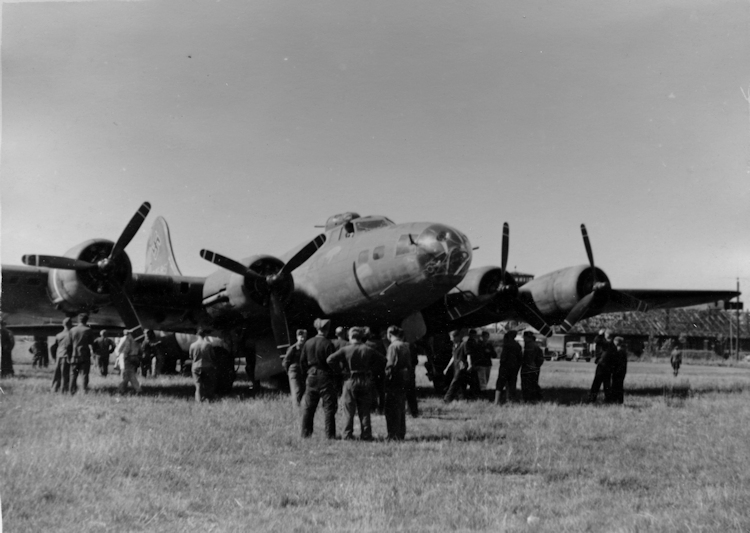
[courtesy of Dave Kerr — click for the full-sized photo]
A wheels-up landing was made in a hayfield near Melun, France (60 miles S.E. of Paris) with ball turret guns pointing downward. Germans were able to transport the B-17 to the nearby Leeuwarden airfield in the Netherlands where repairs made and put in flyable condition. The damaged Ball Turret was never replaced. It was painted with German Insignia and side code DL+XC with yellow paint on the undersurfaces. It was carefully examined and tested at the Luftwaffe Test and Evaluation Center at Rechlin. Wulfe Hound was first flown by the Germans on 17 March 1943, followed by more testing and development of fighter tactics against B-17s. It was transferred to the Luftwaffe "Kampfgeschwader" KG200 Squadron at Rangesdforf, Germany on 11 September 1943. It then took part in training and highly secretive clandestine missions between May and June 1944.
by Mario Schulze
For several years I have known that a captured B-17 was left at the Oranienburg Airfield during the last days of the WWII, and also the fact this plane never took off. The first time I recognized the plane on a US-reconnaissance photo of the airfield made on April 20th, 1945, I knew immediatly that this B-17 could never fly. The right wing seems to be damaged, Also the complete tail section and the plane stood in an oblique position, which means the right landing gear was broken. Right behind the damaged tail a small bomb crater is visible. I believe that the plane was damaged during the USAAF raid on April 10th, 1945, as bombs of 139 B-17s changed the field into a moon landscape. [See: 303rd Bomb Group Mission #357]
Here is an enlargement of the recon photo. The B-17 is within the
white square:
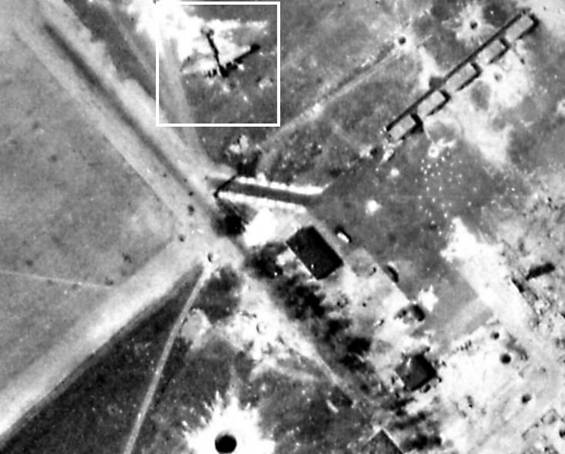
During further research I found more information about this plane. At the Public Record office in London, I located a document made by the Central Allied Interpretation Unit. The Daily Airfield Report No.1018 reported the damaged B-17 at the south west corner of the Oranienburg Airfield. It was sighted on a recon photo of the airfield made by a plane of the 7th US Recon Group on April 14th, 1945. I got also a copy of this picture and have learned that the plane never changed the position during 14th and 20th of April 1945.
The Russians had used the airfield since they reached Oranienburg around April 24th, 1945. After the war they used it as a bomber base. Later they based helicopters on the field, and it was a most interesting place when I was a young boy. After the reunion of East and West Germany in 1990, it was decided that all former Allied Forces had to leave Germany, and also the Russian forces. The Russian helicopter base was closed in 1994 and the unit moved back to their home country. Since that time the former airfield was not in use.
Our authorities decided to change the field to an business area and the former main runway was used for a new highway. But before this could happen, the area had to be cleared of all supposed ammunition, scrap and ruins. The first findings of the B-17 were made in the late 1990's. A rudder of the horizontal stabilizer were found, which unfortunately found their way to militaria memorabilia collectors. I observed it on one eBay auction several years ago.
In 2000 I got my first parts of the plane. They were one of the oil tank service hatches, the fragment of the fuel transfer valve, and some wing structure fragments.
Here are pics of the oil tank filler service hatch and the fuel transfer
valve:
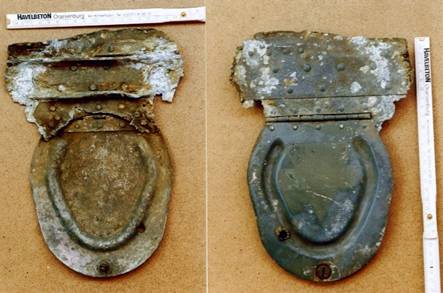
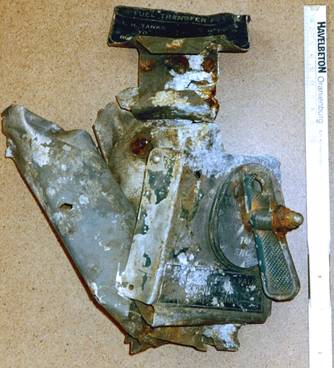
Two years ago I got information from the Chief Assistant of the Sachsenhausen Concentration Camp Memorial, that they have received some parts of a B-17 found at the former Oranienburg airfield. I got the opportunity to see the parts, which are now stored at the Sachsenhausen Memorial. I identified it immediately as part of the left nose side of a B-17F or early B-17G, due to the small first left hand window just behind the plexiglass nose. After I had saw all the parts, I found that it must be a early B-17F. This B-17 must had have the same nose armament configuration as the famous "Memphis Belle," with an large gun window right in the middle of the left nose side.
Here is a picture of the three main parts and the position at the
"Memphis Belle":
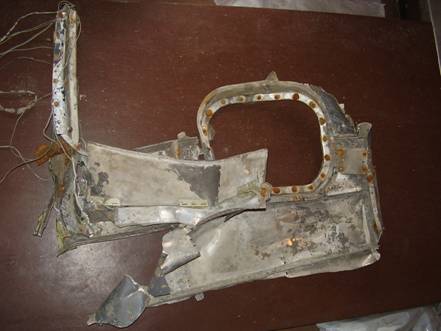
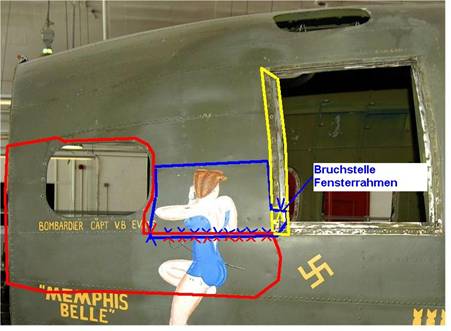
All this time I had no idea of the identity of my "Trojan Horse," but I knew it must have been used by the Luftwaffe's special unit, the Kampfgeschwader (KG) 200. All parts were overpainted in German gray. Later I learned that her underside was painted in bright yellow, over the original US painting of light gray and olive drab. As all the parts which were found at the time, I supposed that this B-17 only could be the "Wulfe Hound" or the 384th BG "Flack Dancer."
In August 2008, I noticed that a new field at the business area was being prepared for a new building. Members of the ammunition recovery service were working at the place where all the parts of the B-17 were recovered. My fellow researcher, Ruediger, called me and gave me the info that a lot of parts of the B-17 were recovered. He only took a service hatch with probably the A/C serial number on it. He gave me the number an I told him "JACKPOT, guy it's the "Wulfe Hound."
Here is a picture of the sad remains of the former beauty:
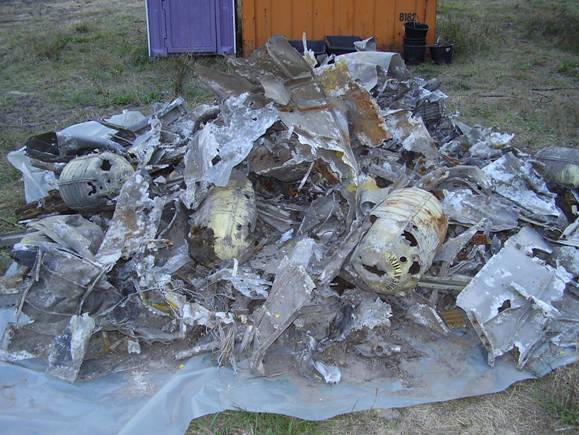
Here's the upper No.1 engine nacelle service hatch with the A/C serial 41-24585:
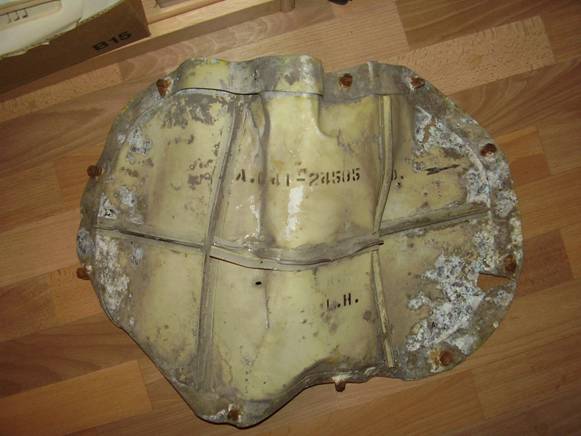
On the next day I found an engine cover plate with the A/C serial number. The outside of the part clearly shows the German colours:
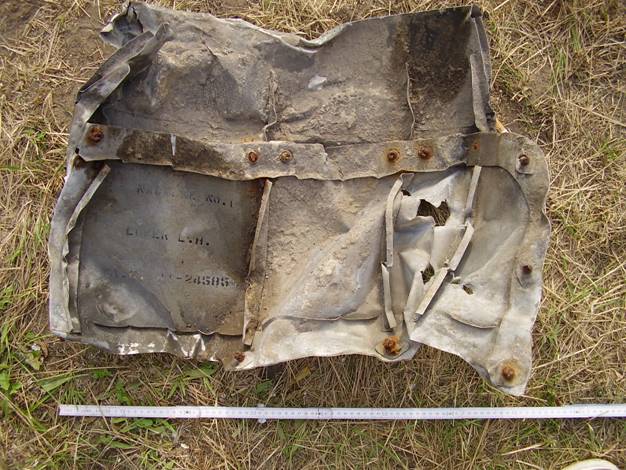

Sadly, before the site could be completely searched, the remaining scrap metal was removed. Our recovered parts are being preserved at the Sachsenhausen Memorial Store, where they are safe.